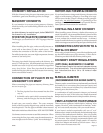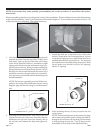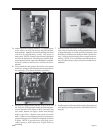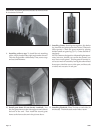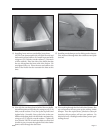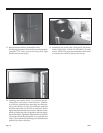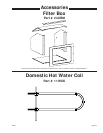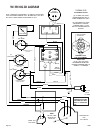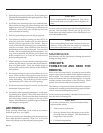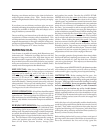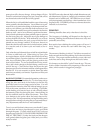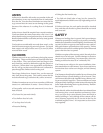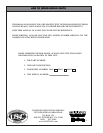
Page 24 USSC
gases given off by the new charge. A deep charge will give
a more even heat and a longer fire, but it may take one to
two hours before the whole bed is fully ignited.
When the fire is well established and the room is becoming
warm, partially close the dampers. You will have to experi-
ment with your particular setting of the damper and con-
trols as your chimney provides the draft necessary to not
only exhaust the smoke, but to pull combustion air into the
heater as well - and no two chimney's perform the same.
Leave the ash pit damper at least partially open to prevent
the fire from going out. Adjust the stove pipe damper to
reduce the draft on the fire. With anthracite you will see
short blue flames above the coal, except when the fire is
started or a new charge is added. If, however, there is no
flame then the fire needs more air from the bottom (unless
it is near the end of its burn cycle and needs to be re-
charged).
Only when the coal is burned down to half its original depth
is it time to add fresh coal. When doing so, open your
stove pipe damper, which will allow the fire to burn off any
accumulated gases. Open the feed door, and with a small
rake, hoe or hooked poker pull the glowing coals to the
front of the firebox. Try not to disturb the fire too much.
Next, add a fresh charge to the back being careful not to
seal off the top. Close the feed door but leave the spin
damper open for a few minutes until the volatile gases have
burned off. It is not necessary to shake down the ashes
each time you refuel your furnace. Experience will be your
best teacher.
BANKING THE FIRE: For extended operation, such as over-
night, you will need to bank the fire. To do so heap coal up
along the sides and back of the firebox so that the fire
gradually burns it over a longer period of time. You will
also reduce the intensity of the fire without letting it go out.
Follow the same procedure as for refueling. If possible,
avoid shaking, as a heavier layer of ash will help reduce
the intensity of the fire during this time. After loading, let
the fire establish itself for about 30 minutes. Then close
your damper to the point where the house does not be-
come too cold. It is important that you begin banking early
enough before retiring or leaving that you can make neces-
sary adjustments after the fire is well established.
To revive a coal fire that is almost out, you should (1) open
the ash door and stove pipe damper to get a good draft
through the grate. (2) place a thin layer of dry coal over
the entire top of the fire. DO NOT POKE OR SHAKE THE
FIRE AT THIS TIME! (3) after the fresh coal has become
well ignited shake the grate (just a little) and you will be
ready to refuel.
DO NOT burn coke, charcoal, high volatile bituminous coal,
sub bituminous, lignite or cannel coal (sometimes called
channel coal or candle coal). NEVER burn wax or chemi-
cally impregnated sawdust logs - their intended use is for
fireplaces only. NEVER fill your stove or furnace above the
firebrick or cas iron liner.
SHAKING
Shaking should be done only when there is a hot fire.
The frequency of shaking will depend on the degree of
burning. Shaking should be done at least once a day and
preferably twice a day.
Best results from shaking the rocker grates will occur if
short "choppy" strokes are used rather than long, even
strokes.
The amount of shaking is critical. Too little or too much of
both can result in the extinguishing of a fire due to blocked
air flow. The proper amount normally occurs when red
coals first start to drop through onto the bed of ashes.
No furnace ever should be "poled" from the top. This can
lead to clinker formation and compacting of the coal and
ashes, which results in clogged air passages.



